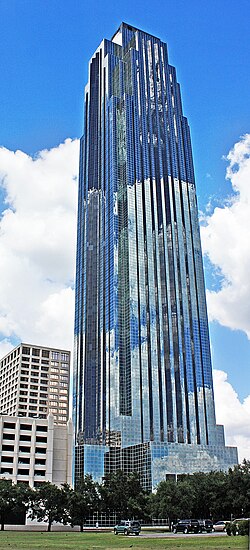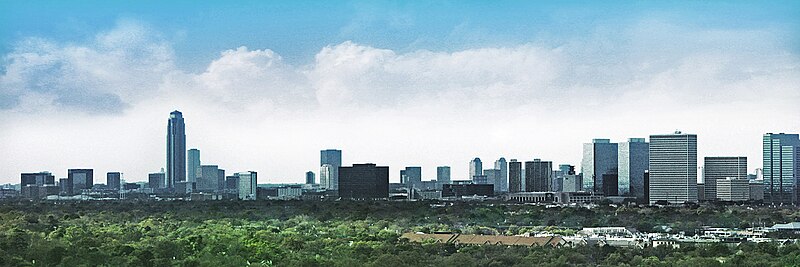Williams Tower
This article needs additional citations for verification. (November 2009) |
| Williams Tower | |
|---|---|
 Williams Tower from street | |
 | |
| General information | |
| Location | 2800 Post Oak Boulevard Houston, Texas |
| Completed | 1983 |
| Cost | $300 million |
| Owner | Hines |
| Height | |
| Roof | 275 m (902 ft) |
| Technical details | |
| Floor count | 64[1] |
| Lifts/elevators | 49 |
| Design and construction | |
| Architect(s) | Philip Johnson and John Burgee Morris Architects (formerly Morris-Aubry Architects) |
| Structural engineer | CBM Engineers Inc. |
The Williams Tower (formerly the Transco Tower) is a skyscraper located in the Uptown District of Houston, Texas in the back of the Houston Galleria. It was designed by architects Philip Johnson and John Burgee, in association with Houston-based Morris Architects (formerly Morris-Aubry Architects), and erected in 1983. The tower is among Houston's most visible buildings. The building is the 4th-tallest in Texas, the 22nd-tallest in the United States, and the 102nd-tallest building in the world. It is the tallest building in Houston outside of Downtown Houston,[2] and at the time of its construction was believed to be the world's tallest skyscraper outside of a central business district. The building has the United States headquarters of the Hines Interests real estate firm.[3]
History
Hines Interests LP was the original developer of the tower. In 2008, an affiliate of Hines purchased the Williams Tower for $271.5 million. The building was offered along with the parking garage, a 2.3 acres (0.93 ha) tract across the street from the Williams Tower, and a 48% stake in the Williams Waterwall and the surrounding park; Hines had already owned the other 52% of the waterwall.[2]
In 2002, Ryan John Hartley climbed the Williams Tower unharnessed and jumped from the 30th story committing suicide.[4] He had on him a political note that did not detail if it was his intention to jump.[5]
Major tenants
The building was originally named for its major tenant, Transco Energy corporation. The name stayed on the building until 1999 after Hines, the building's owner, agreed to change the name of the building some four years after Transco was bought by Williams in 1995. The building once again bears the name of its major tenant, the Williams energy company, which is headquartered in Tulsa, Oklahoma. Even after the name change, the building is often referred to as "the Transco" by long-time Houston residents. In the spring of 2008, Hines again purchased the Tower for 300 million. It is insured at 500 million.

Significance
This section needs additional citations for verification. (November 2009) |
At 64 stories and 909 feet (277 m) above the ground level, the Williams Tower is the tallest building in Houston outside of Downtown Houston.[2] When it was constructed in 1983, it was also the world's tallest skyscraper outside of a city's central business district.[citation needed]
The building is unique[who?] in that it was built to function as two separate towers stacked directly on top of one another, one comprising the first forty floors and the other the forty-first to sixty-fourth. The building has separate banks of elevators and lobbies for each of the two building sections. A majority of the bottom 40 floors are occupied by Williams. The remainder of the building is occupied by a variety of tenants. The building's stepback design suggests one of Johnson's earlier (and smaller) works, the IDS Center in Minneapolis, Minnesota.[citation needed]
Williams Tower was named "Skyscraper of the Century" in the December 1999 issue of Texas Monthly magazine.[6] Paul Gapp of the Chicago Tribune said that the building became an "instant classic" when it opened.[7] Paul Goldberger of The New York Times said that the tower gave Post Oak Boulevard "a center, an anchor, which most outtowns lack."[8]
Features
This section needs additional citations for verification. (November 2009) |

On the 51st floor is a sky lobby and observation deck, which due to security reasons is no longer open to the public. [citation needed]
During the night-time hours, the building is defined by a 7,000 watt beacon that sweeps across the sky and can be seen up to 40 miles (65 km) away on a clear night. Topped by such a beacon, the tower hearkens back to the Palmolive Building in Chicago, Illinois. The building, along with its beacon, is a Houston landmark that identifies the Uptown Houston district.[citation needed]
The building is connected to a 10 level, 3,208 car parking garage by a sky bridge. The bridge also connects the building to retail outlets, like the Galleria and such as, and two Federal Aviation Administration-licensed helipads. In a grass field adjacent to the Williams Tower is another Houston landmark, the Williams Waterwall.[2]
The Houston Business Journal said that the tower was "designed to be energy efficient." The building received the Environmental Protection Agency's Energy Star label for each year since 2000 in which the building was eligible to receive the award. As of 2009 the building managers are seeking to gain Leadership in Energy and Environmental Design (LEED) certification from the United States Green Building Council.[2]
Hurricane Ike
On the morning of September 13, 2008, during Hurricane Ike, the top of the tower was damaged near the rotating beacon and many windows were blown out. The high-rise suffered over $3.5 million in wind damages. Twelve of the 49 elevators were damaged, most by water damage due to roof failures and others due to extreme building sway.
See also
- List of tallest buildings in Houston
- List of tallest buildings in Texas
- List of tallest buildings in the United States
References
This article includes a list of references, related reading, or external links, but its sources remain unclear because it lacks inline citations. (November 2009) |
- ^ "Williams Tower : 2800 Post Oak Boulevard, Houston, Texas :: Glass Steel and Stone". Retrieved 2009-04-17.
- ^ a b c d e "Project Sale: Williams Tower." Houston Business Journal. Friday April 10, 2009. Modified on Saturday April 11, 2009. Retrieved on November 15, 2009.
- ^ "Regional Offices." Hines Interests. Retrieved on December 1, 2009.
- ^ "Authorities: Climber's Death Ruled Suicide". The Associated Press. 2002-12-17. Retrieved 2010-09-10.
- ^ "Man dies after jumping from Galleria-area tower". Houston Chronicle. 2002-12-16. Retrieved 2010-09-10.
- ^ "The Best of the Texas Century—Business." Texas Monthly. December 1999. Retrieved on November 15, 2009.
- ^ Gapp, Paul. "MODERNE REDUX CREATIVE CHURNINGS BREATHE NEW LIFE INTO A NEGLECTED STYLE." Chicago Tribune. March 11, 1987. ARTS, Start page 18. Retrieved on February 18, 2010. "Philip Johnson's Moderne-Deco Transco Tower in Houston, for example, became an instant classic when it was built a few years ago,"
- ^ Goldberger, Paul. "ARCHITECTURE VIEW; When Suburban Sprawl Meets Upward Mobility." The New York Times. July 26, 1987. Page 230, New York Edition. Retrieved on February 18, 2010.
External links
- Williams Tower - Hines Interests
- Williams Tower at Emporis.com
- Williams Tower at Houston Architecture

